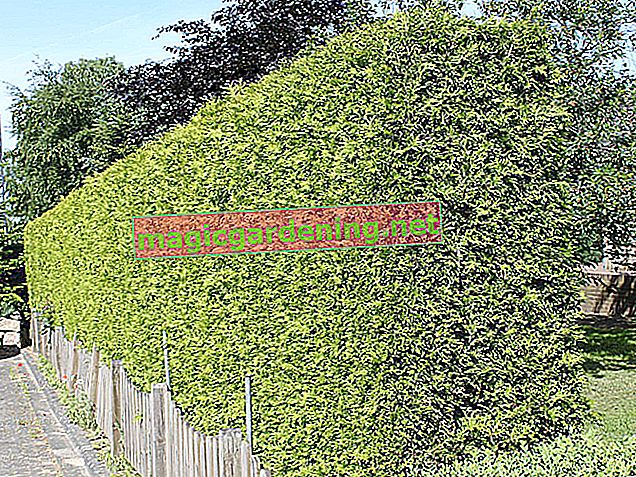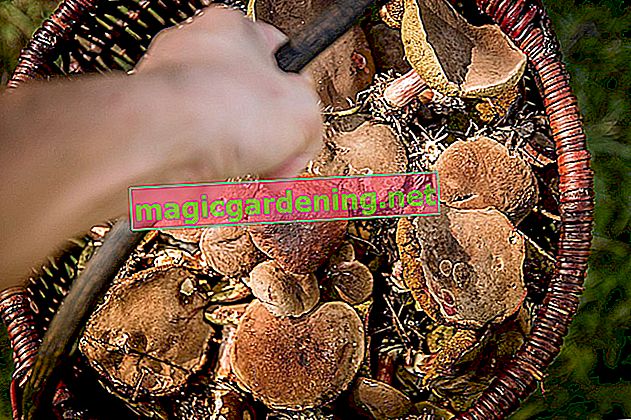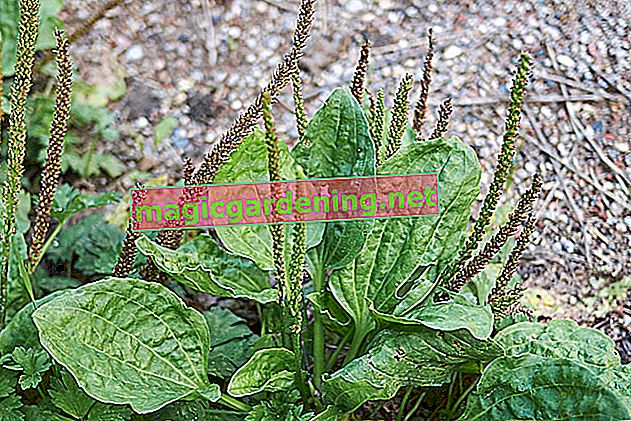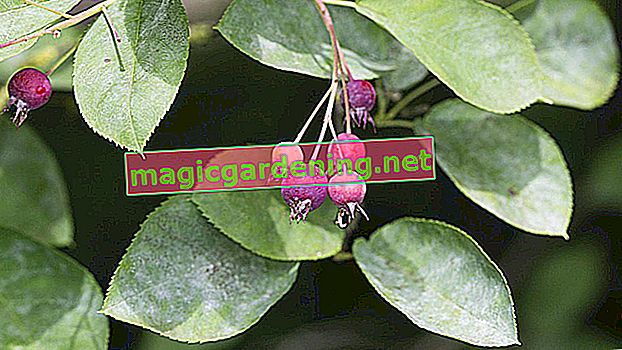
Plant scented geranium properly
The move out of the ice saints in mid-May puts hobby gardeners in a busy activity, because now the planting time of a multitude of summer flowers, such as the beguiling scented pelargonium, begins. The sun worshiper is planted in next to no time, because the procedure goes like this:
- Soak the still potted root ball in water for 20-30 minutes
- Meanwhile, dig a small pit in the sunny spot with 1.5 times the volume of the root ball
- Enrich the excavation with sifted compost and horn shavings
- Pot the fragrant pelargonium and plant in the middle up to the lower pair of leaves
also read
- Scented geranium: what is important when it comes to care?
- The scented geranium does not bloom - cause for concern?
- Propagate scented geranium by cuttings or sowing
The planting proceeds in the same way in the pot and balcony box. In addition, insert some potsherds or pebbles between the substrate and the water drain as drainage.
Care tips
The uncomplicated care program enables even beginners to score points with a scented pelargonium. Successful cultivation rests on these pillars:
- Water moderately with alternating moist soil and drying phases in between
- Fertilize every 2 weeks from April to August
- Regularly clean up withered and faded
- Before the first frost, cut back to 10 cm and clear
The winter geraniums linger in the bright location at temperatures of 5 to 10 degrees Celsius. Only enough water is poured so that the root ball does not come under drought stress. You should stop fertilizing completely by April.
Continue reading
Which location is suitable?
The fragrant pelargonium is one of the garden's sun worshipers. A delicate coat of hair protects the plant from sunburn. So settle geraniums in as sunny locations as possible, warm and surrounded by air. The more hours of sunshine the plant can get hold of, the more abundant the flowering and the more aromatic the scent. The aroma artist does not make any significant demands on the soil quality, because it thrives in any good garden soil that is nutritious, humic, slightly calcareous and well-drained.
What soil does the plant need?
The fragrant pelargonium shows its aesthetic and sensual strengths when it is given this soil quality:
- Nutrient-rich, humus-rich, fresh soil
- First-class drainage without the risk of waterlogging
- Gladly slightly calcareous
In the pot and balcony box, the scented geranium gives its best in structurally stable potting soil with a low proportion of peat, optimized with a little sand or lava granules. (€ 13.76 at Amazon *)
What is the best time to plant?
A fragrant pelargonium has nothing to oppose frosty temperatures. This results in a recommended planting time from mid-May to the end of June. At least the ice saints should have said goodbye before the African fragrance queen moves into the wild. If you want to be on the safe side, wait for the sheep's cold weather at the beginning of June.
When is the flowering time?
The flowering period of a fragrant pelargonium extends from May to September under normal weather conditions. In mild winter years, blooming scented geraniums were spotted in protected locations on Christmas Eve. As long as it doesn't freeze, the plant does its job in the scented and changing garden without ceasing. The top priority is to regularly cut back withered flowers and withered leaves.
Cut the scented geranium correctly
A regular cut contributes significantly to the vitality of a fragrant pelargonium, so that the abundance of flowers and aroma meet the hopes. How to cut a scented geranium properly:
- Shoot young plants once or twice for bushy growth
- Repeatedly cut out dead flowers and withered leaves
- Shorten all shoots to 10-15 cm before storing
Shortly before the overwintered fragrant pelargonium moves into the garden and onto the summer balcony, cut off shoots that are too long to a length of 10 cm. At least two leaf nodes per shoot must remain on the plant for it to sprout again.
Pour the scented geranium
Equipped by mother nature with delicate hairs to protect against evaporation, the scented pelargonium knows how to cope with short-term dryness. In contrast, waterlogging creates life-threatening problems. So water the scented geranium moderately. Only when the substrate surface has dried to a depth of 2 cm is watered. This is less the case in beds than in pots or balcony boxes.
Fertilize scented geranium properly
For a fragrant pelargonium to be able to produce the beguiling scent and the pretty flowers, it is dependent on a regular supply of nutrients. How to fertilize the African beauty as needed:
- From May to August, fertilize organically in the bed every 14 days with compost and horn shavings
- Fertilize liquid in the planter every 2 weeks with a preparation for flowering plants
- Do not use fertilizer from September to April
Overwinter
At home in the warm, sun-drenched regions of South Africa, the fragrant pelargonium cannot stand frost. Multi-year cultivation is still possible if you overwinter the plant like this:
- Before the first frost, remove all leaves and shorten the shoots by up to two thirds
- Leave at least 2 leaf nodes at a height of 10-15 cm on the fragrant pelargonium
- Take the plant out of the container to carefully shake off the used soil
- Put in a flower box (13.19 € at Amazon *) or a box in a mix of potting soil and sand
- Set up in a bright, cool location at 5 to 10 degrees Celsius
During the winter, only enough water is poured so that the earth does not dry out. The fragrant pelargonium does not receive fertilizer. From the end of April, gradually increase the amount of water, fertilize in a diluted concentration and gradually get the plants used to higher temperatures and sunlight. The wintered geraniums can be cleared out in mid-May.
Propagate scented geranium
If you have grown particularly fond of a fragrant pelargonium, you can simply attract offspring with exactly the same attributes. This is possible with the help of cuttings during the months of June and July. How to proceed:
- Non-flowering head cuttings cut with a length of 10-15 cm
- Every shoot in the lower part defoliates except for two pairs of leaves above
- Small pots fill with poor substrate in order to plant 1-2 cuttings of two thirds each
Keep slightly moist in a bright, not full sun place until the seed pot is rooted through. Then transplant your pupils in normal potting soil so that they can be looked after on the sunny windowsill until next May, like an adult scented pelargonium.
Continue reading
Scented geranium does not bloom
If a fragrant pelargonium refuses to flower, the following causes are behind the shortcoming:
- Too little or too much cut: clean out regularly and shorten to a maximum of 10 cm in autumn
- Drought stress or waterlogging: Water moderately when the substrate is dry
- Nutrient deficiency: From April / May to August, fertilize organically every 2 weeks
- Frost damage: Do not plant before mid-May and leave before the first frost
Although the focus of a fragrant pelargonium is on the leaves from which the aroma flows, nitrogen-based fertilization should still be avoided. This drives the growth of the foliage, which, however, is at the expense of a lush abundance of flowers. With organic fertilizer you avoid this problem.
Continue reading
Nice varieties
- Mable Gray: Pink flowers with a deep red heart and a lemony scent, suitable for mosquito shock; Height 90 cm
- Plum Rambler: Rosebud premium variety with cherry-red flowers and a rose-delicate fragrance; Height 60-80 cm
- White Unique: Impresses with white and pink flowers and a sweetish-spicy fragrance; Height 80-90 cm
- Pink Champagne: seduces with a wonderful scent of ginger and bright pink flowers; Growth height 40 cm
- Peach Cream: Magnificent specimen with green-yellow variegated leaves, pink flowers and a scent of peaches; Growth height 30 cm








